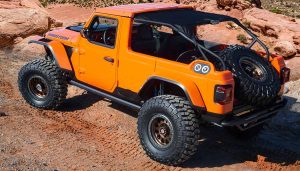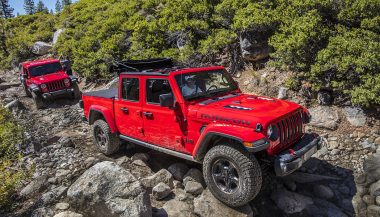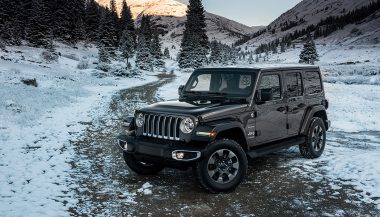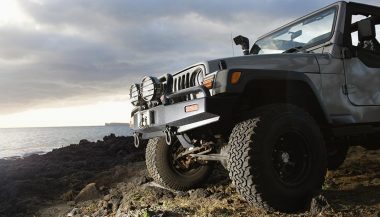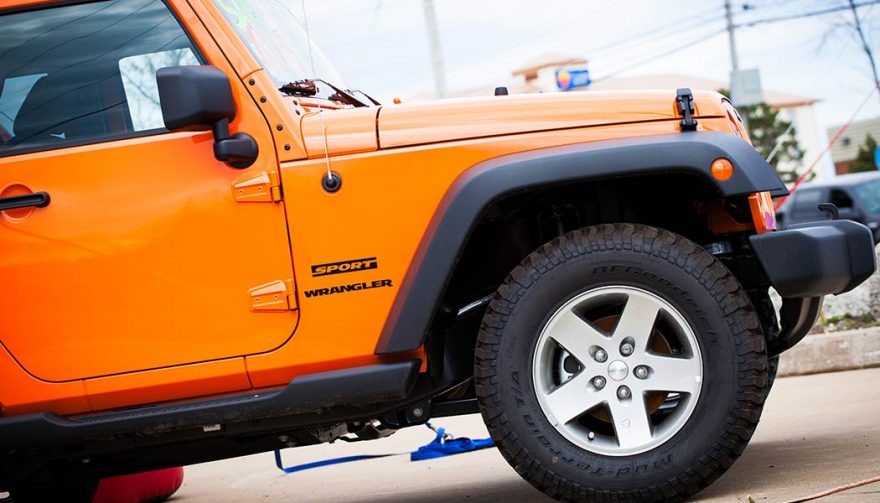
Many Jeep owners lift their vehicle, making it more prone to the Jeep wobble
The Dreaded Jeep Wobble
The dreaded Jeep Wobble, which is otherwise dramatically known by many as the Jeep Death Wobble, is something of a legend among Jeep owners. Some might mistakenly think that it’s a figment of people’s imagination, until one day their own vehicle starts to shake like a leaf in a hurricane. That’s when the questions begin and the skeptical thoughts suddenly end.
To be technically accurate, the Jeep Wobble is actually caused by the front axle of a Jeep spinning unevenly in a violent manner, which of course in turn shakes the rest of the vehicle.
Sometimes the wobble starts off kind of soft and it increases over time, but it usually goes from nothing to a particularly scary situation without any real warning. Often, it’s triggered by one wheel hitting a bump while traveling at a certain speed, something that could happen on any given road.
Dealing with the Jeep Wobble
This might sound like how driving with a really imbalanced tire feels, but it’s actually much worse. Because of all the shaking, the driver can struggle to control the direction of the Jeep, presenting a serious safety issue. Often the problem crops up once the vehicle is traveling at high speeds, such as traveling down the freeway, increasing the risk of an accident without considerable extra care. Needless to say, quite a few Jeep owners have been seriously shook up after having this experience (no pun intended).
If you suddenly find yourself on the receiving end of the Jeep Death Wobble, don’t panic. Keep your hands on the steering wheel, even though that can be a difficult task. Slow the vehicle gradually, avoid slamming on the brakes, and eventually the wobble should decrease and then cease. Pull over without making any quick moves with the steering wheel, then call for help. Trying to drive your Jeep could put you in danger, so it’s best to not take any chances.
Sadly, dealing with the Jeep Wobble comes with the territory if you own a coil-sprung vehicle that has a track bar configuration. For rookies, it’s a problem that’s best left to a professional mechanic. Jeep owners who’ve been around the block a few times can certainly tackle the repair themselves at home, helping them to save some cash. Just remember that while you’re in the midst of fixing the problem and testing to see if the wobble is completely gone, you need to exercise extreme caution.
Figuring Out a Fix
Plenty of Jeep owners assume that fixing the wobble will be quick and easy. Sometimes they’re right, especially if they’re fortunate enough to find that the tires are unbalanced, or that obvious damage is in plain sight.
A quick way to check for damage to the front end of the Jeep is to get on the ground and look at the undercarriage. If you see shiny metal, that’s a sign that something has come loose, which would likely be at least part of the cause of the wobble. Keep in mind that the shaking could make numerous parts come loose, so have your mechanic check everything over thoroughly before you continue on like normal.
The track bar is an extremely common source of the Jeep Wobble. Just one of the bolts being slightly loose can send shivers up your spine, literally, so check each one carefully. Another potential problem area is the bushings, which wear out and develop play in them.
More Areas to Check
Sometimes the Jeep Wobble can be caused by poor wheel alignment. If you haven’t had this checked on your vehicle recently, or if you experienced a hard impact to the wheels while off-roading since you had the alignment done, this is something to definitely investigate. Even a slight bend in a tie rod can make the Jeep shake at higher speeds. With a lifted vehicle, take your rig to a shop that’s familiar with the specifications of the modifications, otherwise you could be dealing with even more problems. If you do discover that the alignment is off for whatever reason, see if you can recreate the problem again, just to ensure there isn’t another source.
While it’s a silly mistake, some Jeep owners accidentally overinflate their tires. Not only can this cause uneven wear, it can also affect the performance of the tires, triggering vibrations at certain speeds.
Ball Joints, Bearings and Tie Rods
Another common cause of the Jeep Wobble is worn ball joints. When this vital component starts to go, one wheel can move in a different way than the opposite wheel, which triggers the wobble. Regardless, discovering that a ball joint is worn out should concern you, because they present a serious danger and so should be replaced immediately.
Bad wheel bearings can also make your Jeep shake like crazy. The same goes for a loose tie rod. If you want to check the ball joints, wheel bearings or tie rods yourself before consulting with a mechanic, it’s actually an easy process. All you need to do is jack up the front end of the Jeep so the tires are off the ground. Grab the sides of the tire and try to move it in different directions. If it shakes, your tie rods, ball joints or wheel bearings likely need to be replaced.
The steering stabilizer bar can also be at the root cause of the wobbling. If the bar comes loose, it can allow for extra vibrations in the front end of the vehicle, which eventually will manifest in some serious shaking. Usually other components will be loose as well, so replacing only the stabilizer bar will only lessen the wobble but not eliminate it entirely.
The Downside of Lifts
Many Jeep owners lift their vehicle, making it more capable on tough trails. The downside is that this can cause problems with the front axle casters. Another issue is that the aftermarket components possibly weren’t installed correctly, either by an inexperienced owner or shop, which could also contribute to wobble.
It’s worth noting that even though it’s called the Jeep Wobble, some other vehicles with a solid front axle can actually experience the same phenomena. Common problem models include various Dodge and Ford trucks, especially the Ford Bronco. The worst thing anyone can do is ignore the Death Wobble, because it’s a sign of a situation that definitely won’t just go away.

